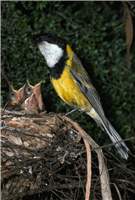Family
Pachycephalidae
Genus
Pachycephala
Species
pectoralis
Threats/Control Methods - Regional
The Golden Whistler depends upon the mountainous eucalypt forests around Canberra for breeding during the spring and summer. Land clearing, grazing and decreasing forest health is minimising the habitat available.
Threats/Control Methods - Local
The birds living in the reserves and ridge areas of the inner north are threatened by attacks from local Cats (Felis catus) and by the development of major roads through the area.
Local/Urban Actions
Cat owners can prevent their pets preying on the species by creating a stimulating indoor environment and by installing a cat run or enclosure. Residents can contribute to the increased health of local native forests by participating in bush regeneration activities, such as those run by local Landcare groups or Greening Australia.
Common Names
Golden Whistler, Golden-breasted Whistler, White-throated Whistler, Golden-breasted Thickhead, Cut-throat, Ring-coachman
Distinguishing Features
The Golden Whistler is a fairly small bird, 16-18cm in size. The Male bird is very boldly coloured, with a glossy black head and bright yellow underparts. His throat is white with a black breast band his eye is red-brown. The back and feathers are olive-green and the tail is dark. The female is pale grey-brown, with slightly darker wings and tail, and a pale creamy-yellow patch under the tail. Young birds are a rusty red colour.
Survey Techniques
Call and visual identification.
Species Call
A loud, persistent musical ring with a whip-like end note: 'whit-whit-wheet-quWHIT'.
Similar Species
The male of this species in similarly coloured to the Crested Shrike-tit (Oreoica gutturalis). The Shrike-tit is unique due to its prominent black crest and much thicker beak.
Distribution
This species has five sub-species found right across Australia, including TAS, from the northern tip of Queensland through the temperate regions to north of Perth. The Golden Whistler is also found in Indonesia, Fiji, New Guinea and the Solomons.
Country of Origin
Australia
Conservation (Pet/Pest) Status - Regional
Population numbers have fluctuated in past years, but a gradual increase is evident (COG).
Conservation (Pet/Pest) Status - National
Secure, not listed under the EPBC Act 1999. The populations of Lord Howe Island and Norfolk Island are considered vulnerable due to their tiny area of occupancy.
LSCCES Population
Moderate numbers were recorded at CSIRO, BMt, ANBG and BMP.
Associated vegetation community
The Golden Whistler resides in rainforest, eucalypt forests and mallee. In the Canberra region it is content in the suburban environment over the winter months.
Limiting Resources
This species requires thick vegetation near the ground. An easily accessable water supply is also needed. Birds travelling into the reserve areas of Canberra during the winter months use vegetation corridors through the suburbs.
Breeding
The breeding season runs from August to January, with the male and female sharing all duties. The nest is built from any materials that can be found locally, including twigs, grass and bark, all bound with a spider web. Two creamy, speckled eggs are laid and incubated for 15 days, by the male during the day and the female by night. The young stay in the nest for about 12 days.
Behaviour
This species migrates into the Canberra region in the wintertime, spending its time quietly foraging for insects in thick shrubs. The bland-coloured female bird is far more likely to be spotted than the male.
Functional Group
Food Species
Small insects, spiders, ants and some berries are eaten by the species. They pick at the bark and leaves from the lower parts of trees and shrubs.
Predators
The Golden Whistler is especially vulnerable to attacks from Cats (Felis catus).
Interesting Fact
This species is one of Australia's loudest and most beautiful songsters, with an especially lovely melody in the spring and summer.
References - (reader suitability of references, P=Primary teachers, S=Secondary students, T=Tertiary students and researchers)
Books:Morcombe, M. 2000. Field Guide to Australian Birds. Steve Parish Publishing. Archerfield. Australia P, S, T
Schodde, R. and Tideman, S. (eds) 1990. Reader's Digest Complete Book of Australian Birds (2nd Edition). Reader's Digest Services Pty Ltd. Sydney. P, S, T
Veerman, P. 2003. Canberra Birds: A report on the first 21 years of the garden bird survey. Philip Veerman and Canberra Ornithologists Group. Canberra. S, T
Internet: Birds in Backyards. 2006. [online]. Available at:http://www.birdsinbackyards.net P, S, T
Canberra Ornithological Group (COG). 2004. Birds of Canberra Gardens. COG and the ACT Department of Urban Services. [online]. Available at:http://garden.canberrabirds.org.au/ P, S, T
Online Publications:ACT Government. 2004. Woodlands for Wildlife: ACT Lowland Woodland Conservation Strategy. Action Plan No. 27. Environment ACT, Canberra. [online]. Available at: http://www.environment.act.gov.au/nativeplantsandanimals/threatecspec/woodlandsstrategy S, T
Garnett, S. and Crowley, M. 2000. The Action Plan for Australian Birds 2000. Department of Environment and Water Resources. [online]. Available at: http://www.deh.gov.au/biodiversity/threatened/publications/action/birds2000/index.html S, T
Nix, H. and Cunningham, R. 2006. Birds of the Lower Sullivans Creek Catchment, Canberra ACT. Prepared for the Life in the Suburbs project using data from the Lower Sullivans Creek Catchment Ecological Survey (LSCCES). Australian National University. Canberra. [online]. Available at: http://www.lifeinthesuburbs.com.au/category.php?id=65 S, T


 Top
Top Top
Top